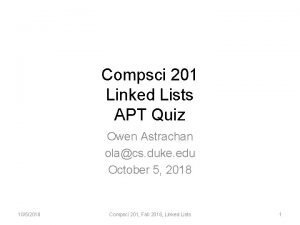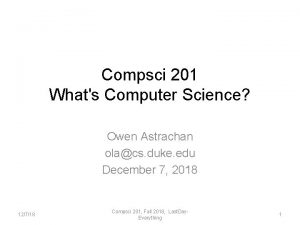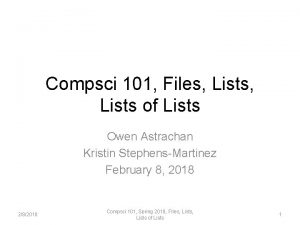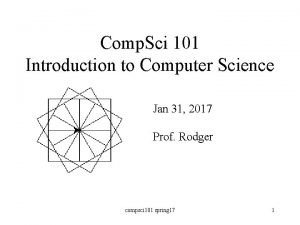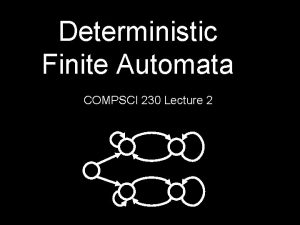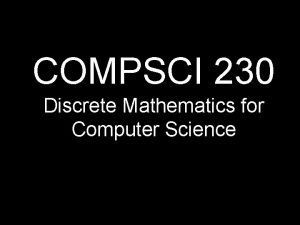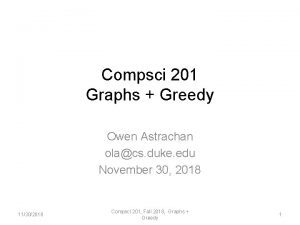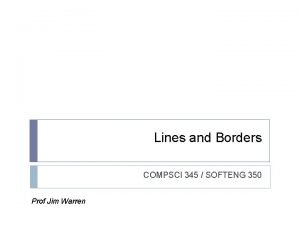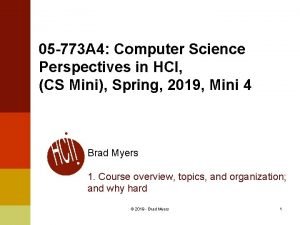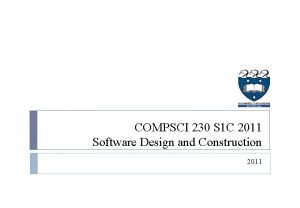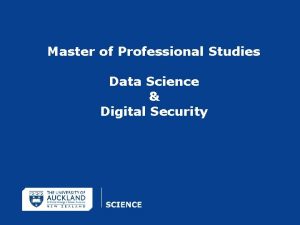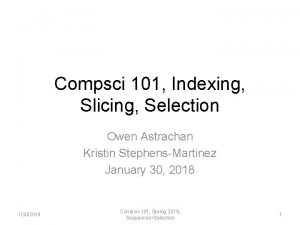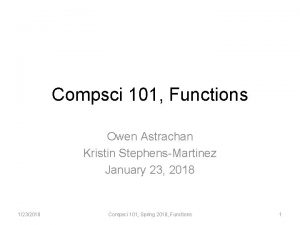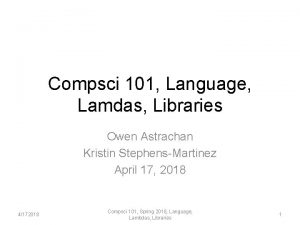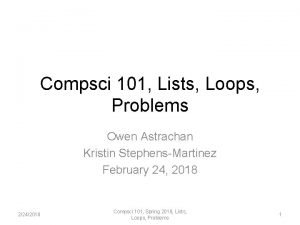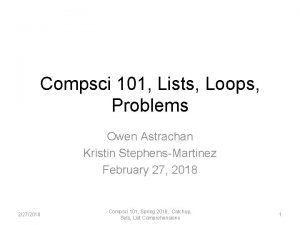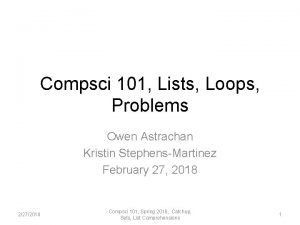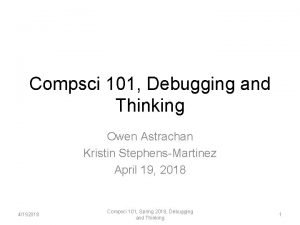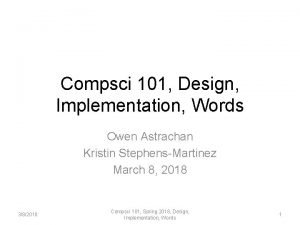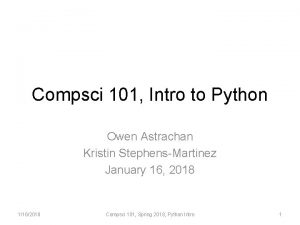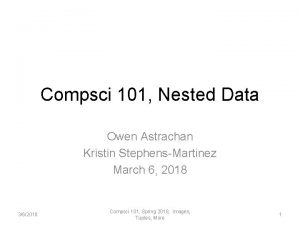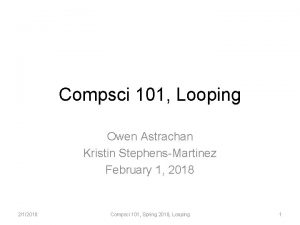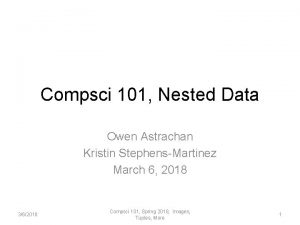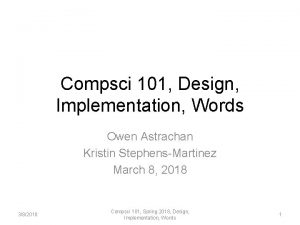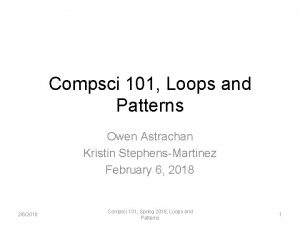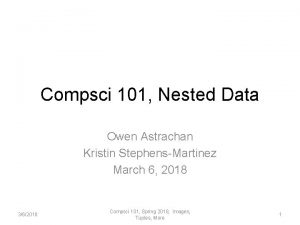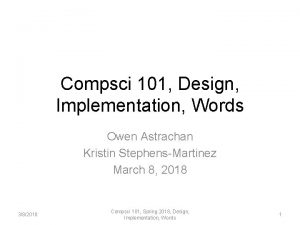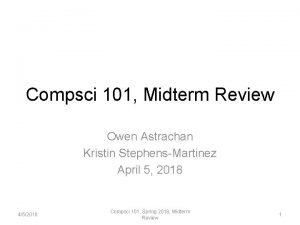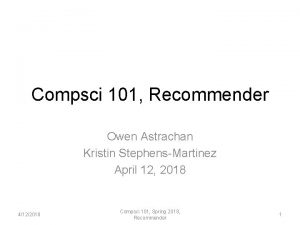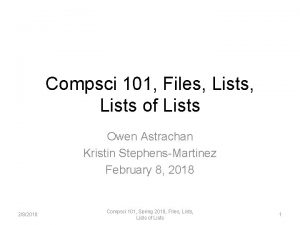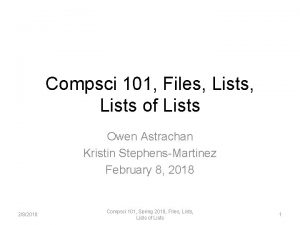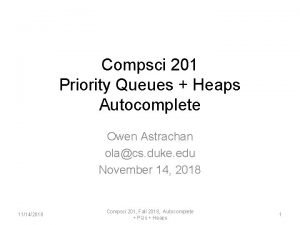Compsci 101 Indexing Slicing Selection Owen Astrachan Kristin




















![Indexing Python Sequences • x="hello world" y=["hello", "world"] • Indexing provides access to individual Indexing Python Sequences • x="hello world" y=["hello", "world"] • Indexing provides access to individual](https://slidetodoc.com/presentation_image_h/2708fc715b0a67e01037812e5208955c/image-21.jpg)
![Slicing Python Sequences • x="hello world" • y=["my", "big", "beautiful", "world"] • Slicing provides Slicing Python Sequences • x="hello world" • y=["my", "big", "beautiful", "world"] • Slicing provides](https://slidetodoc.com/presentation_image_h/2708fc715b0a67e01037812e5208955c/image-22.jpg)







- Slides: 29

Compsci 101, Indexing, Slicing, Selection Owen Astrachan Kristin Stephens-Martinez January 30, 2018 1/30/2018 Compsci 101, Spring 2018, Sequences+Selection 1

E is for … • Escape Sequence • Why n is newline and \s is whitespace • Encryption • From Caesar Ciphers to SSL and beyond • Enumerate • Adding counters to iterable • Emoticon • 1/30/2018 Compsci 101, Spring 2018, Sequences+Selection 2

PFTW • Review Pancake, Selection, Problem Solving • From idea to all-green • Review Totem Assignment • Function definitions, calls, parameters • Sequences: Strings and Lists • Indexing, Slicing, Combining • Lists and Loops (Thursday) • Iteration and Appending 1/30/2018 Compsci 101, Spring 2018, Sequences+Selection 3

Pancake Concepts/Tools • Solve by hand – required before programming! • What are edge cases? Identify and solve • Zero pancakes, # pancakes < size of pan, … • Write down steps? Maybe good idea for many • Translate ideas into code? Or words into code! • New and Review. Compsci Python 101, Spring 2018, 1/30/2018 Sequences+Selection • // and % and if … 4

Three versions of is_vowel def is_vowel(ch): if ch =='e': return True if ch == 'a': return True if ch == 'i': return True if ch == 'o': return True if ch == 'u': return True return False 1/30/2018 def is_vowel(ch): c = "aeiou". count(ch) if c > 0: return True else: return False def is_vowel(ch): return "aeiou". count(ch) > 0 Compsci 101, Spring 2018, Sequences+Selection 5

Finishing the APT Pancake Problem • Use the algorithm developed AFTER verifying with pencil and paper aka by hand • Test first in our Eclipse (VM or Local) • Create main program block • Call minutes. Needed with several examples • Use APT testing system, submit, reflect • Can we have more than one return statement? 1/30/2018 Compsci 101, Spring 2018, Sequences+Selection 6

Pancake Code/Algorithm • There are some special cases not shown below • Understand // and % operators for int values • Testing locally and in APT tester full. Pans = num. Cakes//capacity left. Over = num. Cakes % capacity if left. Over ==0: return full. Pans*10 if left. Over <= capacity/2: return full. Pans*10+5 return(full. Pans+1)*10 1/30/2018 Compsci 101, Spring 2018, Sequences+Selection 7

How to teach pancake flipping • http: //www. youtube. com/watch? v=W_gx. LKSs. SIE • Is this computer science? http: //bit. ly/zyk. Orh • For longer, more complex robotic tasks • http: //www. youtube. com/watch? v=4 uso. E 981 e 7 I • Do robots matter? • Do they dream? • Self-driving cars? • Machine learning? 1/30/2018 Compsci 101, Spring 2018, Sequences+Selection 8

Selection Summarized • We can use selection: if statement • if boolean_condition: block • What can change? Boolean and block • What is a boolean condition? True/False • See type(3 < 5) • Relational operators: < <= > >= == != • Boolean operators: and or not 1/30/2018 Compsci 101, Spring 2018, Sequences+Selection 9

Sir Tim Berners-Lee • Turing award 2016 • World Wide Web • HTTP vs. TCP/IP • Just protocols? I want you to realize that, if you can imagine a computer doing something, you can program a computer to do that. Unbounded opportunity. . . limited only by your imagination. And a couple of laws of physics. 1/30/2018 Compsci 101, Spring 2018, Sequences+Selection 10

Creating Selfies 1/30/2018 Compsci 101, Spring 2018, Sequences+Selection 11

Learning Goals: Totem • Understand differences and similarities: • Function definitions, function calls • Functions that return values, those that don’t • Functions with parameters, those without • Be creative and learn lesson(s) about software design and engineering • Create a small, working program, make incremental improvements. • Read the directions and understand specifications! 1/30/2018 Compsci 101, Spring 2018, Sequences+Selection 12

Terminology and Progress • What is def eyes_crossed(): • Does this return a value? Type? • How do you call the function? • What is def head_happy(): • Where do you call it? What does it return? • Let’s examine a whole head function from write-up 1/30/2018 Compsci 101, Spring 2018, Sequences+Selection 13

Anatomy of a whole head • What does doc-string mean/do? What is it? • What are the function calls here? • What about with a different nose? def head_funny(): """ Print a head that looks a little funny, With surprised mouth and eyebrows """ print(hair_plain()) print(eyes_withbrows()) print(nose_big()) print(mouth_surprised()) print(chin_plain()) 1/30/2018 Compsci 101, Spring 2018, Sequences+Selection 14

Anatomy of a whole head • How similar is this to head_funny? • What are differences? Find and parameterize! def head_sad(): """ Print a head that looks a little sad, With sad mouth and eyebrows """ print(hair_plain()) print(eyes_withbrows()) print(nose_big()) print(mouth_sad()) print(chin_plain()) 1/30/2018 Compsci 101, Spring 2018, Sequences+Selection 15

Parameterize Whole Head • Call head_funny(mouth_surprised) • What is call? What is parameter? • Can’t write call below, why? Small difference!! • head_funny(mouth_surprised()) def head_funny(mouth_func): """ Print a head that looks a little funny, With surprised mouth and eyebrows """ print(hair_plain()) print(eyes_withbrows()) print(nose_big()) print(mouth_func()) print(chin_plain()) 1/30/2018 Compsci 101, Spring 2018, Sequences+Selection 16

Parameterize Whole Head • What does a totem function look like? • Why does head_funny not have return value? • What type is parameter to head_funny? • Names, types, values! def totem_fixed(): """ totem poles with different mouths """ head_funny(mouth_surprised) head_funny(mouth_angry) head_funny(mouth_tired) 1/30/2018 Compsci 101, Spring 2018, Sequences+Selection 17

WOTOTOTEM http: //bit. ly/101 spring 18 -jan 30 -1 • Read carefully, build slowly • Create a running program and ensure it does run 1/30/2018 Compsci 101, Spring 2018, Sequences+Selection 18

Additional Tools for Building • We need sequences to access and create data • Documents rather than words • Spread sheets rather than single data/formula • Operations on these sequences • Access all elements: loops • Access elements selectively: if statements 1/30/2018 Compsci 101, Spring 2018, Sequences+Selection 19

Python Sequences • Types String and List share characteristics • Both are sequences, have a length • Both support indexing and slicing • Conversion functions help connect them • x="hello world" y=["hello", "world"] • What is len(x)? • String is immutable, list is mutable 1/30/2018 Compsci 101, Spring 2018, Sequences+Selection 20
![Indexing Python Sequences xhello world yhello world Indexing provides access to individual Indexing Python Sequences • x="hello world" y=["hello", "world"] • Indexing provides access to individual](https://slidetodoc.com/presentation_image_h/2708fc715b0a67e01037812e5208955c/image-21.jpg)
Indexing Python Sequences • x="hello world" y=["hello", "world"] • Indexing provides access to individual elements • Compare x[0]and y[0] • Start with 0, what is last valid positive index? • Compare x[-1] and y[-1] • What is negative index of second to last element? • Index –n is the same as index len(seq) - n 1/30/2018 Compsci 101, Spring 2018, Sequences+Selection 21
![Slicing Python Sequences xhello world ymy big beautiful world Slicing provides Slicing Python Sequences • x="hello world" • y=["my", "big", "beautiful", "world"] • Slicing provides](https://slidetodoc.com/presentation_image_h/2708fc715b0a67e01037812e5208955c/image-22.jpg)
Slicing Python Sequences • x="hello world" • y=["my", "big", "beautiful", "world"] • Slicing provides sub-sequence (string or list) • Compare x[0: 3]and y[0: 3] • What is length of subsequence? seq[2: 4] • Compare x[4: -1] and y[2: -1] • Is last index part of subsequence? • We can omit value, e. g. , x[2: ] or x[: 4], good shortcut! 1/30/2018 Compsci 101, Spring 2018, Sequences+Selection 22

One more APT • Let’s have Brunch with the Digerati • https: //www 2. cs. duke. edu/csed/pythonapt/po rtmanteau. html • Read the problem statement carefully • Why can’t we create netizen in function? Combination of “internet” and “citizen” • How do we solve with slicing? 1/30/2018 Compsci 101, Spring 2018, Sequences+Selection 23

Anatomy of Python String • String is a sequence of characters • Strings cannot be changed: immutable • Strings parameters to built-in functions: len • Operators can be applied: [n] and [m: n] • Methods/functions applied ON strings • "HELLO". lower() • "the duke way". split() 1/30/2018 Compsci 101, Spring 2018, Sequences+Selection 24

Split and List Preview • Lists can be heterogenous sequence • Strings, ints, lists, anything • Contrast String: sequence of characters • Lists can grow: read from file for example • Contrast String: immutable/cannot change • “one fish two fish”. split() is a list • How many elements? See Lab this week! 1/30/2018 Compsci 101, Spring 2018, Sequences+Selection 25

Bug and Debug • software 'bug' • Start small • Easier to cope • Judicious 'print' • Debugger too • Verify the approach being taken, test small, test frequently, add to working code • What does “working code” mean? 1/30/2018 Compsci 101, Spring 2018, Sequences+Selection 26

if, else, elif, oh my! • Leap years, ugh, but … • Show statement order matters, trace it! • https: //en. wikipedia. org/wiki/Leap_year def is_leap_one(year): def is_leap_two(year): if year % 400 == 0: if year % 4 == 0: return True if year % 100 == 0: return False if year % 4 == 0: if year % 400 == 0: return True return False 1/30/2018 Compsci 101, Spring 2018, Sequences+Selection 27

Wikipedia Leap Algorithm • See algorithm section • https: //en. wikipedia. org/wiki/Leap_year def is_leap_(year): if year % 4 != 0: return False # not leap elif year % 100 != 0: # 1968 return True elif year % 400 != 0: return False #1968 else return True #2000 1/30/2018 Compsci 101, Spring 2018, Sequences+Selection 28

Slicing WOTO http: //bit. ly/101 spring 18 -jan 25 -2 • Correctness counts! 1/30/2018 Compsci 101, Spring 2018, Sequences+Selection 29
 Owen astrachan
Owen astrachan Owen astrachan duke
Owen astrachan duke Duke compsci 101
Duke compsci 101 Owen astrachan
Owen astrachan Pre-coordinate indexing
Pre-coordinate indexing Contoh pengindeksan manual
Contoh pengindeksan manual Duke compsci 101
Duke compsci 101 Difference between continuous and discontinuous variation
Difference between continuous and discontinuous variation Multiway selection in c
Multiway selection in c Similarities
Similarities Example of stabilizing selection
Example of stabilizing selection Mass selection
Mass selection K selection r selection
K selection r selection Logistic model of population growth
Logistic model of population growth Natural selection vs artificial selection
Natural selection vs artificial selection Two way selection and multiway selection in c
Two way selection and multiway selection in c Natural selection vs artificial selection
Natural selection vs artificial selection Balancing selection vs stabilizing selection
Balancing selection vs stabilizing selection Compsci 345
Compsci 345 Compsci 732
Compsci 732 Compsci 230 duke
Compsci 230 duke Compsci 230
Compsci 230 Duke compsci 201
Duke compsci 201 Compsci 111g
Compsci 111g Softeng 350
Softeng 350 Compsci 773
Compsci 773 Compsci 230
Compsci 230 Tower of hanoi state space
Tower of hanoi state space Compsci 111
Compsci 111 Compsci 762
Compsci 762
